
In the botanical classification of plants, Aeridinae Pfitzer is a subtribe of the tribe Vandeae whose representatives all have a monopodial growth habit and do not possess pseudobulbs.

The taxonomy of the Orchidaceae (orchid family) has evolved slowly during the last 250 years, starting with Carl Linnaeus who in 1753 recognized eight genera. De Jussieu recognized the Orchidaceae as a separate family in his Genera Plantarum in 1789. Olof Swartz recognized 25 genera in 1800. Louis Claude Richard provided us in 1817 with the descriptive terminology of the orchids. (See External links below). The next step was taken in 1830-1840 by John Lindley, who recognized four subfamilies. He is generally recognized as the father of orchid taxonomy. The next important step was taken by George Bentham with a new classification, recognizing subtribes for the first time. This classification was first presented in a paper that Bentham read to the Royal Society in 1881. Then it was published in 1883 in the final volume of Genera Plantarum. The next great contributors were Pfitzer (1887), Schlechter (1926), Mansfeld (1937), Dressler and Dodson (1960), Garay (1960, 1972), Vermeulen (1966), again Dressler (1981). and Burns-Balogh and Funk (1986). Dressler's 1993 book had considerable influence on later work.
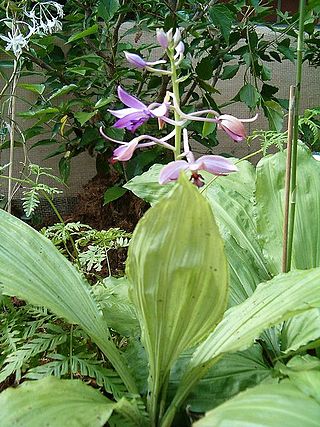
Calanthe, commonly known as Christmas orchids, is a genus of about 220 species of orchids in the family Orchidaceae. They are evergreen or deciduous terrestrial plants with thick roots, small oval pseudobulbs, large corrugated leaves and upright, sometimes arching flowering stems. The sepals and petals are narrow and a similar size to each other and the labellum usually has spreading lobes.

Laeliinae is a Neotropical subtribe including 40 orchid genera, such as Brassavola, Laelia and Cattleya. The genus Epidendrum is the largest within this subtribe, containing about 1500 species. This is followed by the genus Encyclia, with over 120 species.

Aeridostachya is a genus of orchids.
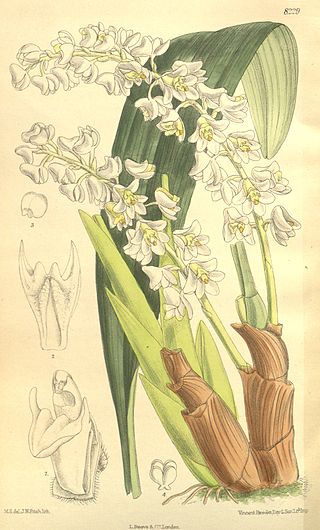
Bryobium, commonly known as urchin orchids or 藓兰属 , is a genus of flowering plants in the family Orchidaceae. Orchids in this genus are epiphytic or lithophytic plants with large, fleshy pseudobulbs, each with up to three leathery leaves and small, often hairy flowers. These orchids are found from tropical Asia to northern Australia.

Cylindrolobus is a genus of orchids with about 80 species that grow in New Guinea, Wallacea, Southeast Asia, southern China, and India.

Pinalia, commonly known as gremlin orchids, is a genus of flowering plants in the family Orchidaceae. Orchids in this genus are large epiphytic or lithophytic plants with prominent pseudobulbs, each with up to three thin, flat leaves and cup-shaped, relatively short-lived flowers with scale-like brown hairs on the outside. There are about 120 species occurring from tropical to subtropical Asia to the south-west Pacific.
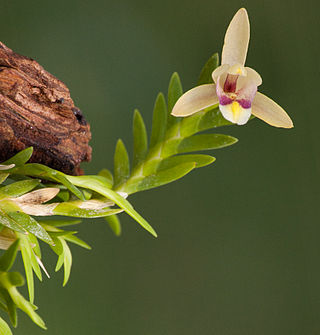
The Vandeae is a large monophyletic tribe within the family of orchids.
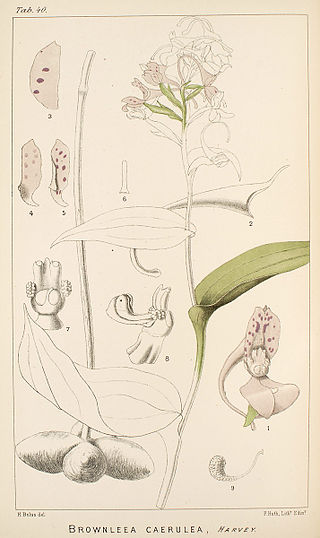
Brownleea is a genus of flowering plants from the family Orchidaceae native to Africa and Madagascar. Eight species are known.
- Brownleea coeruleaHarv. ex Lindl.
- Brownleea galpiniiBolus
- Brownleea graminicolaMcMurtry
- Brownleea macrocerasSond.
- Brownleea maculataP.J.Cribb
- Brownleea mulanjiensisH.P.Linder
- Brownleea parvifloraHarv. ex Lindl.
- Brownleea recurvataSond.
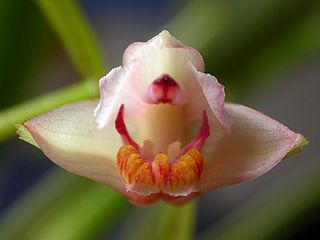
Cryptochilus is a genus of flowering plants from the orchid family, Orchidaceae. Its species are native to China, the Himalayas, and Indochina.

Diploprora is a genus of flowering plants from the orchid family, Orchidaceae. It contains two recognized species, native to Asia:

Myrmechis is a genus of flowering plants from the orchid family, Orchidaceae. It is native to eastern and southeastern Asia from the Kuril Islands south to New Guinea, west to the Himalayas.
- Myrmechis aurea(J.J.Sm.) Schuit. - Maluku
- Myrmechis bakhimensisD.Maity, N.Pradhan & Maiti - Sikkim
- Myrmechis bilobulifera(J.J.Sm.) Schuit. - Sulawesi
- Myrmechis chalmersii(Schltr.) Schuit. - New Guinea
- Myrmechis chinensisRolfe - Sichuan, Hubei, Fujian
- Myrmechis drymoglossifoliaHayata - Taiwan
- Myrmechis glabraBlume - Java
- Myrmechis gracilis(Blume) Blume - Java, Sumatra, Philippines
- Myrmechis japonica(Rchb.f.) Rolfe - Japan, Korea, Kuril Islands, Fujian, Sichuan, Tibet, Yunnan
- Myrmechis kinabaluensisCarr - Sabah
- Myrmechis perpusillaAmes - Luzon
- Myrmechis philippinensiisAmes - Philippines
- Myrmechis pumila(Hook.f.) Tang & F.T.Wang - Yunnan, Bhutan, Assam, Myanmar, Nepal, Thailand, Vietnam
- Myrmechis quadrilobata(Schltr.) Schuit. - Sulawesi
- Myrmechis seranicaJ.J.Sm. - Seram
- Myrmechis tsukusianaMasam. - Yakushima
- Myrmechis urceolataTang & K.Y.Lang - Yunnan, Guangdong, Hainan
Platylepis is a genus of flowering plants from the orchid family, Orchidaceae. It is widespread across sub-Saharan Africa and also on various islands of the Pacific and Indian Oceans.
- Platylepis bigibbosaH.Perrier - Madagascar
- Platylepis bombusJ.J.Sm. - Seram
- Platylepis commelynae(Lindl.) Rchb.f. - Society Islands
- Platylepis constricta(J.J.Sm.) J.J.Sm. - New Guinea
- Platylepis densifloraRolfe - Réunion
- Platylepis geluana(Schltr.) Schuit. & de Vogel - New Guinea
- Platylepis glandulosa(Lindl.) Rchb.f. - widespread across tropical and southern Africa
- Platylepis grandiflora(Schltr.) Ormerod - New Caledonia, Vanuatu, Futuna
- Platylepis heteromorphaRchb.f. - Samoa
- Platylepis intricataSchuit. & de Vogel - Papua New Guinea
- Platylepis lamellataSchltr. - New Guinea
- Platylepis margaritiferaSchltr. - Madagascar
- Platylepis occulta(Thouars) Rchb.f. - Madagascar, Réunion, Mauritius, Seychelles
- Platylepis polyadeniaRchb.f. - Madagascar, Comoros
- Platylepis rufa(Frapp.) Schltr. - Réunion
- Platylepis tidorensisJ.J.Sm. - Maluku
- Platylepis viscosa(Rchb.f.) Schltr. - Réunion
- Platylepis xerosteleOrmerod - Cameroon
- Platylepis zeuxinoidesSchltr. - New Guinea

Angraecinae is a subtribe in the family Orchidaceae. The subtribe consists of approximately 47 genera. The type genus is Angraecum. Most of the genera are endemic to Africa, Madagascar and other Indian Ocean Islands, a few genera can also be found in the Americas.

Podochileae is an orchid tribe in the subfamily Epidendroideae.

Thelasiinae is an orchid subtribe in the tribe Podochileae.

Porpax is a genus of epiphytic orchids native to southern and southeastern Asia from India to Yunnan to Borneo. As of March 2021, Plants of the World Online accepts the following species:
Pinalia chrysocardium is a species of orchid. It is native to Sumatra. It was reassigned from the genus Eria.
















